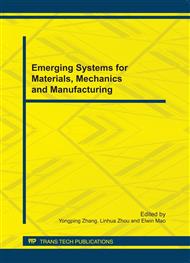[1]
R. Agrawal, R. Srikant. Mining Sequential Pattern. In: Pro. of the 11st Int. Conf. on Data Engineering, Taipei, March 1995, pp.3-14.
Google Scholar
[2]
L Getoor. Multi-relational data mining using probabilistic relational models: research summary[C]. In: Proceedings of the First Workshop on Multi-relational Data Mining, (2001).
DOI: 10.1007/978-3-662-04599-2_13
Google Scholar
[3]
S Wrobel. Inductive Logic Programming for Knowledge Discovery in Databases[C]. In.
Google Scholar
[1]
2001: 74~101.
Google Scholar
[4]
He Jun, Liu hongyan, Du xiaoyong, mining of multi-relational association rules[J]. Journal Of Software, 2007, 18(11): 2752-2765.
Google Scholar
[5]
Dehaspe L, de Raedt L. Mining association rules in multiple relations. In: Dzeroski S, Lavrac N, eds. Proc. of the 7th Int'l Workshop on Inductive Logic Programming. LNAI 1297, Berlin: Springer-Verlag, 1997. 125−132.
DOI: 10.1007/3540635149_40
Google Scholar
[6]
Dehape L. Frequent pattern discovery in first-order logic [Ph.D. Thesis]. Belgium: Katholieke Universiteit Leuven, (1998).
Google Scholar
[7]
Nijssen S, Kok J. Faster association rules for multiple relations. In: Nebel B, ed. Proc. of the 17th Int'l Joint Conf. on Artificial Intelligence (IJCAI 2001), Vol. 2. 2001. 891−896.
Google Scholar
[8]
Jensen VC, Soparkar N. Frequent itemset counting across multiple tables. In: Terano T, Liu H, Chen ALP, eds. Proc. of the 4th Pacific-Asia Conf. of Knowledge Discovery and Data Mining, Current Issues and New Applications. LNCS 1805, Berlin: Springer-Verlag, 2000. 49−61.
DOI: 10.1007/3-540-45571-x_8
Google Scholar
[9]
Ng EKK, Fu AW, Wang K. Mining association rules from stars. In: Kumar V, Tsumoto S, eds. Proc. of the 2002 IEEE Int'l Conf. on Data Mining (ICDM 2002). Los Alamitos: IEEE Computer Society, 2002. 322−329.
DOI: 10.1109/icdm.2002.1183919
Google Scholar
[10]
G Stumme, R Taouil, Y Bastide, et al. Computing iceberg concept lattices with titanic[J] . Journal on Knowledge and Data Engineering, 2002, 42( 2 ): 189-222.
DOI: 10.1016/s0169-023x(02)00057-5
Google Scholar
[11]
ZAK IM. SPADE: An efficient algorithm for mining frequent sequences[J]. Machine Learning, 2001, 41( 1 /2 ): 31- 60.
Google Scholar


